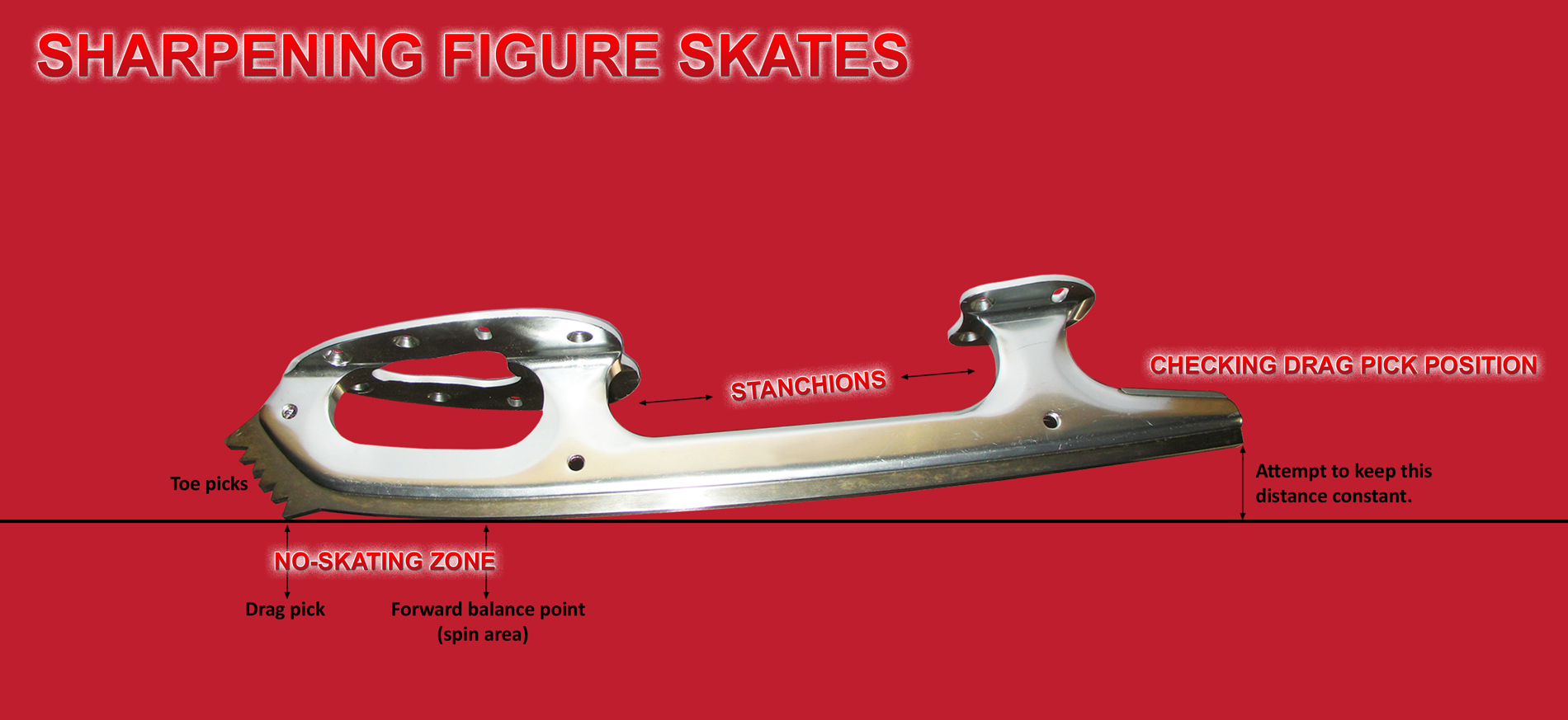More knowledge
Specialization
Here is more skate sharpening information
Depth of hollow
When speaking of hollowness it is good to know that a larger radius (e.g. 26 mm) gives a shallower hollow while a smaller radius (e.g. 13 mm) gives a deeper hollow. You can adjust this by screwing the diamond dresser inwards or outwards in the pivot device.
For those curious to know the actual depth of the hollow you can calculate it using this formula: D = (W² / 8R) * K, where the factor K is near 1, K = 2 / (1 + √(1 - W² / 4R²)) and D = Depth, R = Radius of hollow and W = Width of skate blade.

Figure skates
Some say that sharpening figure skates is an art that only few will master. Sharpening figure skates is not that difficult. However, there are some things you have to think of. Figure skates are wider than regular skates and they have toe picks (master picks and a drag pick) that cause some unconvenience when sharpening. The blade thickness also varies among figure skating categories. When sharpening a figure skate, try to get as near to the drag pick as possible without touching it.
The bottom toe pick (or drag pick) should be ground down an amount equal to that you have sharpened away from the skate blade. Otherwise the drag pick will get a different relative position than when the blade was new. An easy way to check this is as follows: before you start sharpening, you place the skate blade against a flat surface, tilt the blade so that the drag pick touches the flat surface and measure the distance at the rear end between skate blade and flat surface. This distance should be kept constant. After you have sharpened the skate you should measure again and then remove material from the drag pick so that you restore the previous distance. By doing it like this you will always have the same angle between skate blade and drag pick.
If you lean the blade forward against the ice, you can only go so far before hitting the drag pick. This position is called the "Forward Balance Point". When you spin, you are skating on this point, with the drag pick just touching the ice. Because of the drag pick, you cannot skate on the part of blade between the forward balance point and the drag pick. This no-skating zone does not come in contact with the ice. New blades are not sharpened in this area and there is really no need for a hollow sharpening here. Instead when you grind down the drag pick to keep the skate blade construction in the same angle you can grind down this area a bit as well.
A general rule is that good figure skaters should use a ROH between 11-16 mm (7/16"-5/8"). Advanced skaters can go as shallow as 19 mm (3/4").
Goalie skates
There are many different ways to sharpen goalie skates depending on your style of playing and how you want them to feel.
The "stand-up" goalies generally want a shallow hollowness around 16 - 25 mm (5/8'' - 1'') since they are going to move in all directions (especially forward to cut off shooting angle) and slide sideways a lot. The "butterfly" goalies generally want a deeper hollowness around 9 - 13 mm (3/8'' - 1/2'') since they move up and down a lot and need to dig into the ice. This is the most common style today.
The "offset" sharpening is where you want different height on the edges underneath your skate blades. Here you want a higher inside edge (digs deeper) and a lower outside edge (can lead to excellent pushes and a smooth shuffle). This sharpening can easily be obtained using our built-in height adjusting devices so you always get the same preferred offset sharpening. This style is not so common today.
Plastic ice
Sharpening skates for a plastic ice is a bit different compared to regular sharpening. When a skate has been used on plastic ice, the skate blade will be covered with plastic material. This needs to be removed before sharpening. The easiest way to do this is by using some sort of solvent. You might also have to clean the blade support roller in a similar way after sharpening a skate since the plastic material will get there as well. The grinding wheel will also get this plastic material on it, decreasing its effectiveness. So you need to dress it more often than usual.
When skating on plastic ice you should always have your skates sharpened with a hollowness. Otherwise you will not get any grip at all. You should also use a deeper hollowness than what you normally have when skating on regular ice. Those who are used to skate on flat sharpening should have a hollowness around 25 mm. The plastic ice is very tough on your skates so you will have to resharpen quite often (around every 1-2 hours).
Ice temperature
There is a difference between skating on a hard (fast) ice compared to skating on a soft (slow) one. When skating on a soft ice (above -5 °C) your skates will sink deeper into the ice. This makes you move more slowly and you will get more tired. A hard ice (-5 to -8 °C) requires more edge to give a good grip.
By adjusting the hollowness you can get the same feeling on both types of ice. A soft ice requires a more shallow hollowness while a hard ice requires a somewhat deeper hollowness compared to your standard hollowness.